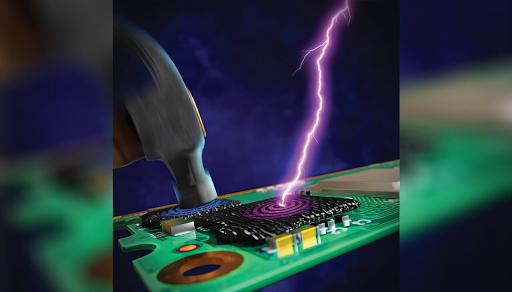By Micah Chaban, RapidMade INC
Electrostatic discharge (ESD) is an invisible but costly threat in industries that rely on sensitive electronics. From manufacturing circuit boards to assembling aerospace components, preventing static buildup is crucial. Traditionally, companies turned to machining and thermoforming to produce ESD-safe parts. Now, 3D printing is reshaping the landscape, offering a faster, more flexible, and cost-effective alternative.
The Rise of ESD-Safe 3D Printing
For years, additive manufacturing was seen as a prototyping tool. But as 3D printers have improved, so have the materials available—including ESD-safe plastics. Engineers and manufacturers can now create custom, static-dissipative parts on demand, reducing lead times and costs.
How Does It Work?
Unlike standard plastics, ESD-safe 3D printing materials contain conductive additives—typically carbon, graphene, or metal particles—to create a pathway for static charges to dissipate. The result? A material that behaves like regular plastic but prevents static buildup.
Popular ESD 3D Printing Materials
- ESD Nylon 12 – Strong, durable, and great for end-use parts.
- ESD ABS – A reliable option for enclosures and fixtures.
- Carbon-filled PLA & PETG – Budget-friendly choices for less demanding applications.
Why Industries Are Making the Switch
Traditional ESD manufacturing methods—like CNC machining—offer precision, but they come at a price: high costs, long lead times, and design limitations. 3D printing eliminates many of these challenges.
Key Advantages:
✅ Faster Production – Small-batch parts can be printed in days, not weeks.
✅ Design Freedom – Complex geometries are possible without tooling costs.
✅ Cost Savings – Ideal for low- to medium-volume production.
Challenges to Consider
❌ Material Limitations – Fewer ESD-safe options compared to machining.
❌ Surface Finish – May require post-processing for smoothness.
❌ Mechanical Strength – Some materials lack the durability of machined parts.
The Science Behind ESD 3D Printing
How do these materials actually work? It all comes down to conductivity.
How Conductive Additives Prevent Static Buildup
- Carbon and Graphene: Tiny conductive particles create a network that allows static to dissipate.
- Metal-Infused Polymers: Fine metal powders improve conductivity without making the material brittle.
- Surface Resistance: Measured in ohms, the ideal range for ESD materials is 10⁶ to 10⁹ ohms—conductive enough to prevent charge buildup but not so conductive that it interferes with electrical components.
The Role of Print Settings in ESD Performance
Not all 3D-printed ESD parts perform equally. Printing parameters affect conductivity, including:
- Layer Height: Thinner layers ensure better conductivity across the part.
- Infill Percentage: Higher infill leads to more consistent static-dissipation properties.
- Print Temperature: Needs to be optimized to prevent material degradation and ensure even distribution of conductive additives.
Regulatory & Industry Standards
When manufacturing ESD-safe components, compliance with industry standards is essential.
Key ESD Standards for 3D-Printed Parts
- ANSI/ESD S20.20 – The global benchmark for electrostatic control in electronics manufacturing.
- IEC 61340-5-1 – Specifies ESD protection guidelines for handling sensitive components.
- MIL-STD-1686 – U.S. military standard for ESD control in defense applications.
Challenges in Certifying 3D-Printed ESD Parts
Unlike machined materials, 3D-printed parts can have inconsistent conductivity due to differences in layer bonding, infill, and print orientation. Companies must conduct rigorous testing to ensure compliance, often measuring:
✔ Surface resistivity using ohmmeters.
✔ Charge dissipation rates under controlled conditions.
✔ Consistency between prints to avoid batch variation.
Where Is ESD 3D Printing Being Used?
The biggest adopters of ESD-safe 3D printing include:
🔹 Electronics Manufacturing – Custom jigs, fixtures, and enclosures.
🔹 Aerospace & Automotive – Lightweight, static-dissipative interior parts.
🔹 Medical & Cleanrooms – Dust-resistant trays and instrument cases.
Future Trends & Innovations
Advancements in Conductive Polymers
Material scientists are developing next-generation ESD filaments that improve upon traditional carbon-based options. Some of the most promising innovations include:
- Carbon Nanotube-Infused Plastics – Superior conductivity without compromising strength.
- Graphene Composites – Stronger, more durable, and potentially recyclable.
- Recyclable Conductive Filaments – A push toward sustainable ESD solutions.
Hybrid Manufacturing: The Best of Both Worlds
Combining 3D printing with CNC machining is emerging as a powerful approach. Companies can 3D print ESD-safe parts, then machine critical surfaces to achieve high precision where needed.
Sustainable ESD Materials
As environmental concerns grow, manufacturers are exploring bio-based and recycled conductive plastics. The challenge? Maintaining conductivity while using eco-friendly materials. Research is ongoing, but the future looks promising.
Conclusion
For companies that need fast, flexible, and affordable ESD-safe parts, 3D printing is proving to be a game-changer. While traditional methods still have their place, additive manufacturing is making static-dissipative components more accessible than ever.
By understanding the strengths and limitations of each approach, businesses can optimize their manufacturing strategy to balance cost, performance, and production efficiency.
For expert guidance on custom ESD solutions, contact RapidMade today!
📩 Email: info@rapidmade.com
🌐 Visit us: rapidmade.com
